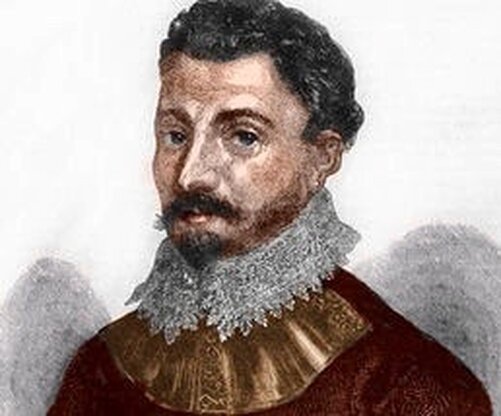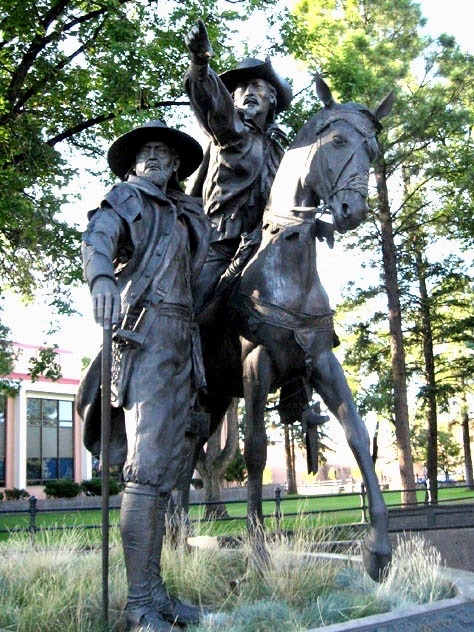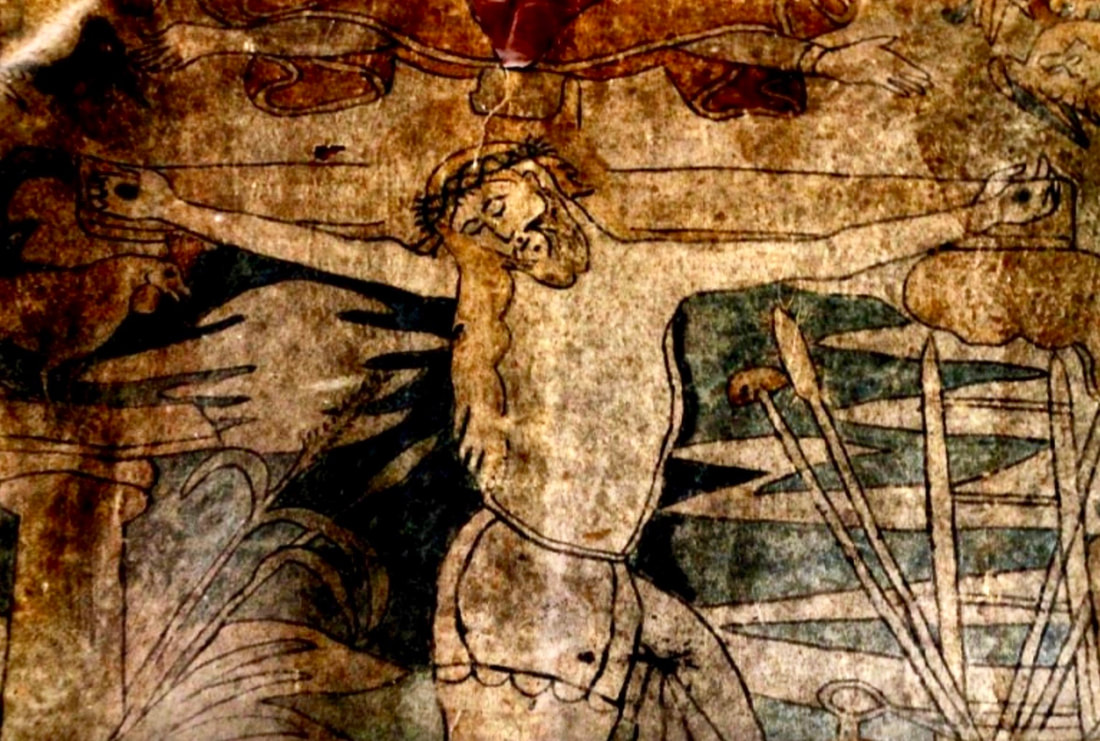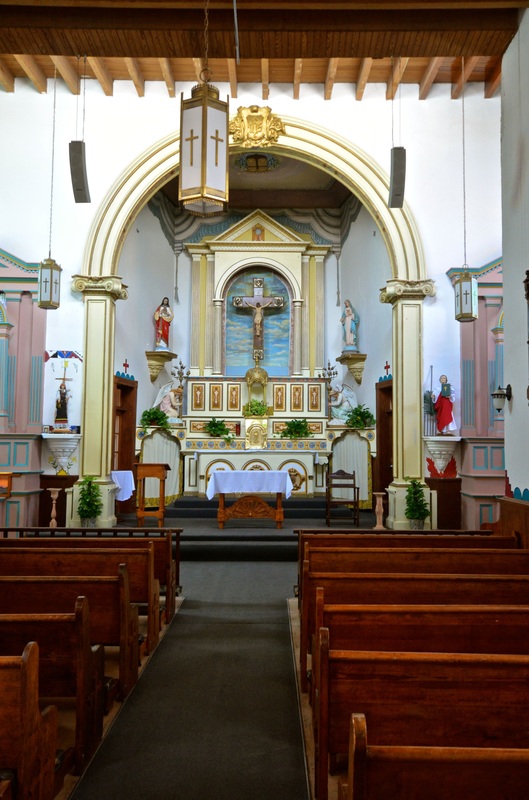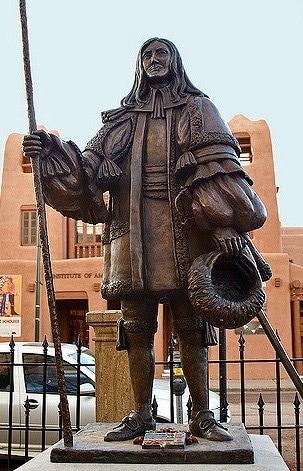Hispanic-American History Timeline
Cronología de la Historia Hispano-Americana
By Lehman College CUNY Students
17th Century 1602-1695
|
Spanish explorer Sebastian Vizcaino sails north along the Pacific Coast from Acapulco to San Miguel, which he renames San Diego de Alcala -- now the city of San Diego, California.
In search for new trade routes that would improve the economy of New Spain (Mexico), Vizcaino takes three ships -- The San Diego, The Santa Tomas, and The Tres Reyes -- with 200 soldiers and sailors, three Catholic friars and his 13-year-old son Juan. On his mission to expand Spain's northwestern trading frontier, he follows the shoreline first explored by Juan Rodriguez Cabrillo 60 years earlier. But Vizcaino visits and names many California landmarks, including Monterey Bay, Santa Catalina Island, San Pedro, Santa Barbara, Point Conception, the Santa Lucia Mountains, Carmel Bay and the Carmel River. Before reaching present-day California, Vizcaino had taken possession of the Baja California peninsula and named it Nueva Andalucia. And after returning to Mexico, in 1611, Vizcaino went to Japan, where he led a Japanese delegation that charted and mapped the coastline. Today, the Royal Presidio Chapel, a National Historic landmark in Monterey, California, commemorates Vizcaino's landing at Monterey Bay. Vizcaino's story is depicted on the facade of the California Building at Balboa Park in San Diego, California. Quotes from the diary of Vizcaino's journey are on a plaque in the McCoy House Museum, in the old town of San Diego State Historic Park. By Flor Johnson, Lehman College |
1602 |
Mission Santa Catalina de Guale
|
|
As part of Spain’s efforts to covert Native Americans to Catholicism, Spanish Franciscan friars open Santa Catalina de Guale, a mission and town on present-day St. Catherines Island, and the first Spanish outpost in Georgia. Florida governor Pedro Menendez de Aviles and other Spanish explorers have visited the area since 1566. And while the Spanish establish several mission/villages along the east coast of present-day northern Florida and Georgia, Guale grows to become the center of missionary work in Spanish Florida.
And yet epidemic diseases reduce the town’s population, and attacks from pirates, slave raiders and British-backed natives force the mission to move south to Sapelo Island, Ga., in 1680 and again to Amelia Island in present-day Florida in 1684. The Westo Indians, who capture and sell other Indians as slaves, and who raid Spanish settlements with support and encouragement from the British, are primarily responsible for the setbacks to Spanish colonization and evangelization. The mission remains on Amelia Island, consolidating natives from various other attacked mission/villages until 1702, when it is attacked and destroyed by British forces from South Carolina and Guale residents flee further south to St. Augustine. Today, St. Catherine's Island is owned by foundation devoted to promoting conservation, natural resources and endangered species. The island is declared a National Historic Landmark in 1969. |
|
Spanish Army officer Don Pedro de Peralta, appointed second governor of New Mexico, arrives at its capital, La Villa de San Gabriel, and decides to move the capital to a new town. He establishes and names Santa Fe, New Mexico.
Replacing Governor Juan de Oñate, who had made many enemies among the natives, Peralta travels to New Mexico with only 12 soldiers and eight Franciscan priests, who are determined to convert the natives to Catholicism. While the missionaries promise the natives that baptism would protect them from deceases, Peralta convinces some 200 San Gabriel settlers that the capital is erroneously located in an area that suffers drought, lacks fertile land, and is also too far from the Pueblo Indian population centers. Peralta selects an alternative site, with better land and a water good supply, and a surveyor designs the new settlement, which is separated by districts, home and garden plots, and including a downtown area, Santa Fe Plaza, for commerce and government buildings. The Plaza is designed to hold "1,000 people, 5,000 head of sheep, 400 head of horses, and 300 head of cattle without crowding." It features a chapel, a jail, an arsenal, and the governor's headquarters and government offices, the Palace of the Governors, which is built with three-foot-thick adobe walls to protect Spanish authorities from native attacks. It goes on to serve as the New Mexico seat of government for centuries. Three years after Peralta establishes Santa Fe, a Franciscan friar, Isidro Ordóñez, falsifies documents which give him as much power Peralta, accuses Peralta of mistreating the natives, has Peralta imprisoned and takes temporary control of the New Mexico government. After almost a year in prison, Peralta is allowed to return to Mexico City, where he explains his version of his dispute with Ordóñez and where he is finally vindicated by the Mexican Inquisition. The Inquisition orders Ordóñez to return to Mexico City, and reprimands him. Peralta went on to serve on in various government post in Spanish America, from Mexico to Venezuela. Today, Peralta rides a horse, with his surveyor standing next him, in a bronze statue called "The Founding of Santa Fe," in the city's Peralta Park. The Santa Fe Plaza is now the heart of downtown Santa Fe. The Palace of the Governors now houses the Museum of New Mexico and is considered to be the oldest continuously occupied public building in the United States. Both the Palace and the Plaza have been designated National Historic Landmarks. By Anthony Valero, Lehman College |
|
1610-26The Birth of San Miguel,
|
1613 Juan Rodriguez becomes the first Manhattan immigrant
|
Juan Rodriguez, a native of the what is now the Dominican Republic, becomes the first immigrant in Manhattan. This is 12 years before Dutch colonists establish New Amsterdam, and 51 years before the English take control of the colony and rename it New York.
Born in Santo Domingo of a Portuguese sailor and an African woman, Rodriguez arrives on a Portuguese ship and decides to stay. He marries a Native American woman and establishes a family. He builds a very lucrative business, trading furs for European tools with the natives and the explorers who came to the New World. But he is not only the first immigrant. Rodriguez is also the first person of both European and African heritage to live in Manhattan. And he is not only the first Latino, he is the first New York Dominican! In 2012, New York City recognized him by co-naming a portion of Broadway, "Juan Rodriguez Way." In two predominantly Dominican neighborhoods, from 159th Street in Washington Heights to 218th Street in Inwood, many people now can look up an see streets signs recognizing that one of their ancestors arrived here first! |
|
Misión San Luis de Apalachee is established by Franciscan friars Pedro Munoz and Francisco Martinez, in present-day Tallahassee, Florida, to covert the Apalachee Indians to Christianity and colonize the Florida Panhandle.
Built in Anhaica, the capital village of the Apalachee Indians, the most powerful and advanced tribe in Florida, Mision San Luis becomes a community unlike any other in Florida, where Spaniards and Apalachees live and work together, and marry each other. Anhaica, the village first encountered by the Hernando de Soto expedition in 1539, is already a wealthy agricultural Apalachee community when San Luis is established. But the mission brings European knowhow and San Luis' crops are soon feeding soldiers and settlers in St. Augustine, the Spanish capital of Florida. In fact, when the mission is moved and expanded to a more secure location in 1656, the San Luis community has the largest number of European settlers in Florida, outside of St. Augustine. In 1656, when the Spanish government decides to built an outpost in northerwest Florida and encourages San Luis settlers to relocate the mission to a nearby, more defendable, hilltop location, the San Luis Spanish settlers and Apalachee Indians move the mission, build a church and fortified house (casa fuerte), and become a colonial community of some 1,400 people, including a powerful Apalachee chief and the Spanish deputy governor. But in 1704, following a series of raids by the English and Creek Indians, San Luis is evacuated and destroyed. The Spanish and some of the Apalachees return to St. Augustine, and about 800 Apalachees flee west to Mobile, a French village where they settle for some time. Almost three centuries later, in 1996, the site where Mission San Luis stood was added to the U.S. National Registry of Historic Places. And in 1998, drawing from 15 years of historical and archaeological research, the rebuilding of San Luis begins. In 2000, the San Luis church celebrates its first Mass in almost 300 years. From 2000 to 2009, many other buildings are added to the reconstructed settlement, including a Convento, a Council House, the Chief's House, the fort "Castillo de San Luis," a Blockhouse, and a Typical Spanish House. Of the many mission settlements established by Spain in Florida, San Luis is the only reconstructed mission in the state. This tourist attraction is made even more impressive by its "living historic interpreters" -- real people representing historic figures and recreating life at it was in San Luis in 1703. By Clara Chavira, Lehman College |
|
COMING SOON: 1680 The Pueblo Revolt
|
Copus Christi de San Antonio de la Ysleta del Sur, the first Spanish mission in present-day Texas, is established by Fray Francisco de Ayeta and Antonio de Otermin, the Spanish governor of New Mexico, in El Paso, Tx.
First used as a temporary refugee camp for Pueblo Indians who were fleeing from Apache raiders, the mission flourishes as an agricultural community, the first of several established by Spaniards and Native Americans near the Rio Grande. These were people who were returning north to Texas after fleeing south from northern New Mexico during the Pueblo Revolt of 1680. Built with mud and chinked logs, the mission was forced to relocate several times due to fires and flooding of the Rio Grande, but one of the original church bells still survives. Today, the Ysleta community is not only recognized as the oldest in Texas, and it's parish is not only the oldest continuously operated church in the state, but it also claims the oldest continuously cultivated plot of land in the country. Today, the Ysleta church still serves the descendants of the Tigua people who first converted to Catholicism more than 500 years ago. Every year, they still celebrate the feast of St. Anthony of Padua, the mission's patron saint. By Annie Malembe, Lehman College |
|
1688 |
Runway British Slaves
|
|
Diego de Quiroga, the Spanish Governor of Florida, grants sanctuary in St. Augustine to eight men, two women and a three-year-old girl who escape British slavery on a stolen raft - once they convert to Roman Catholicism.
The two women worked as domestic helpers in the governor's home. Two of the men were employed as blacksmiths, and the other six worked on the construction of Castillo de San Marcos. They were all paid for their labor. In spite of efforts by British slave owners to regain their property, de Quiroga resisted, and protected them. But they were only the first. Spanish records show that at least six separate groups of runaway British slaves escape from South Carolina to St. Augustine, the capital of Spanish Florida, between 1688 and 1725. Most of them made the journey after 1693, when the Spanish Crown officially granted them freedom after they arrived in Florida. |
|
First comes La Misión San Cayetano de Tumacácori (years later replaced by Mission San José de Tumacácori). One day later, came La Misión de San Gabriel de Guevavi, which years later became known as Misión Los Santos Ángeles de Guevavi.
Tumacácori and Guevavi are the first two missions to be established in preset-day Arizona by Father Eusebio Kino, who is on a quest to convert the O'odham natives of the region to Christianity. With time, the Tohono O'odham not only adopt the Catholic religion, but the Spanish language. Today, more than three centuries later, the decedents of the Tohono O'odham still speak their native pima language as well as Spanish. Today, both missions are part of the Tumacácori National Historical Park. The Mission San José de Tumacácori complex is open to the public. Nearby are the park's visitor center and the Tumacácori Museum. The Guevavi mission is not open to the general public, but can be visited on reserved tours led by park staff. There are statues of Father Kino in Phoenix, Nogales, and Tucson, Arizona. He also stands in a bronze statue in the National Statuary Hall in the U.S. Capitol, in Washington, D.C. By Mary Addy, Lehman College |
|
|
Father Eusebio Kino, an Italian-born Jesuit missionary and explorer, establishes the Spanish Catholic mission San Xavier del Bac in southern Arizona.
On a mission to spread Christianity among the Tohono O'odham natives of the area, in the past year, Kino already has established two nearby missions, at Tumacácori and Guevavi, and now becomes the first non-Indian to visit the village of Bac. He already has established many other missions in present-day northern Mexico, and he goes on to establish more mission in Arizona. He also conducts several expeditions on horseback, covering and mapping more than 200 miles -- all along teaching the natives how to raise cattle and crops. Kino's original San Xavier church is rebuilt from 1783 to 1797 - 14 years! - by Native Americans and Franciscan missionaries who have taken control of the mission. The church is known as "The White Dove of the Desert," because it appears that way when seen from a distance. With its combination of Moorish, Byzantine and late Mexico Renaissance architecture, and with its interior walls packed with numerous hand-carved and brightly painted wooden angels and saints, San Xaxier remains as perhaps the best example of mission construction in the U.S. It's one of the few places in the United States where you can step back in time by entering an authentic 18th-century space. The church still serves the descendants of the Tohono O'odham natives Kino converted to Catholicism. It also has become a place of pilgrimage for many people who go there to fulfill promises to the patron saint of the mission, San Francisco Xavier, another missionary who was one of the founders of the Jesuit order. By Juana Arellano, Lehman College |
|
|
Don Diego de Vargas, the Spanish Governor of New Mexico, leads a military expedition to reconquer Santa Fe and other territory that was taken by Native Americans during the Pueblo Revolt of 1680. Leading a 200-men army, he peacefully gains control over numerous pueblos without firing a single shot.
Twelve years after the Pueblo people drove Spanish settlers out of New Mexico, and forced them to retreat to present-day northern Mexico and southern Texas, De Vargas conducts a "bloodless reconquest" that turns many former enemies into allies. He uses Catholic rituals to persuade the natives that he wants peace. But De Vargas' repossession of New Mexico doesn't remain peaceful. When some natives refuse to submit to his rule, he retaliates violently and in many ways, from cutting off their water supply to having 70 opposing Pueblo warriors executed. Many natives side with the Spanish, but violent skirmishes with rebelling natives continue until 1694. A devout follower of the Virgin Mary, De Vargas prays to her as "La Conquistadora" (The Conqueress). He believes that it was her who granted his initial peaceful re-entry into Santa Fe, and he celebrates a feast in her honor. That feast is still celebrated nowadays by the descendants of the reconquest, both Native Americans and Hispanics who come together to commemorate peace between the two groups. The city's annual "Fiestas de Santa Fe," is a novena of thanksgiving masses and a procession, usually in mid-September, carrying a wooden statue of La Conquistadora from her permanent home in the Cathedral Basilica of St. Francis of Assisi to the Rosario Chapel. These "Fiestas de Santa Fe" are said to be the oldest civic and religious celebrations of their kind in North America. De Vargas is also recognized with a statue in Cathedral Park, adjoining the Basilica, in downtown Santa Fe. By Jonell Payamps, Lehman College |
|
Workers brought from Havana, Cuba, complete the construction of Castillo de San Marcos, the stone colonial fort built to replace nine wooded fortifications that guarded St. Augustine, the Spanish capital of Florida, from British or pirate attacks.
Guarding downtown St. Augustine, on the shoreline of Matanzas Bay, the impressive star-shaped fort, which took 23 years to build, is surrounded by a moat, fortified by powerful cannons, and divided into four bastions, named San Pedro, San Agustin, San Carlos and San Pablo. Made of "Coquina" (small seashells bonded together), which is similar to limestone, the powerful fort becomes an important New World military outpost for many years. When the British Navy laid siege on St. Augustine in 1702, the Castillo sheltered the town's 1,500 residents and soldiers. In spite of a two-month battle, British cannons had little effect on the coquina walls. Today, Castillo de San Marcos stands as the oldest masonry fort in the continental United States. A National Monument managed by the United States National Parks Service, the Castillo is the biggest tourist attraction in St. Augustine and a popular icon of representing centuries of Hispanic presence in North America. By Lurie Gonzalez, Lehman College NEW DETAILS: See Stop 9 from my summer 2022 road trip: Castillo de San Marcos, St. Augustine, Fl. https://www.hiddenhispanicheritage.com/on-the-road-again.html |
|
Go to: 16th Century 18th Century
Please note that this timeline is devoted to the Hispanic presence in North America starting on April 2, 1513. While Latin America Timelines obviously begin much earlier, and cover the history of our antecedents in Latin America and Spain, they often exclude everything that happened in North America - even the accomplishments of the conquistadores who came north from the Caribbean and Mexico, and the Hispanics who followed them! With our timeline, our goal is to fill the huge gaps that leave U.S. Hispanics out of U.S. history.
What's Missing? Que Falta?
|
Help us build this timeline! Click:
https://www.facebook.com/HiddenHispanicHeritage And tell us: Which major historical event are we missing? |
´Ayúdenos a construir esta cronología! Clic:
https://www.facebook.com/HiddenHispanicHeritage Y díganos: Qué gran evento histórico nos estamos perdiendo? |
|
Are you on Twitter? For Updates on HiddenHispanicHeritage.com
Please follow me: @ColumnistPerez https://twitter.com/ColumnistPerez |
|



